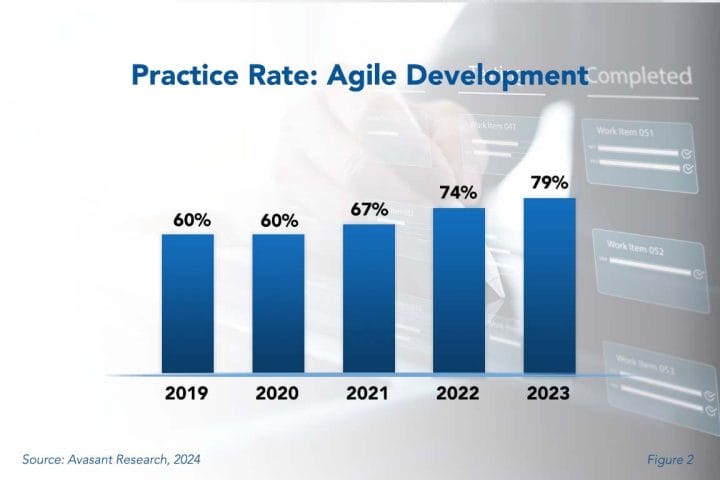Organizations have been steadily increasing their investment in Agile software development. Agile helps businesses reduce development cycles and respond more quickly to changing markets and customer demands. Once considered useful only to software companies and big tech, Agile has been adopted by enterprises of all types.
As shown in Figure 2 from our full report, Agile Development Best Practices, 79% of survey respondents practiced Agile development in 2023, while 74% practiced it in 2022. In 2019, 60% practiced Agile. The 19-percentage point increase over four years indicates strong momentum and a trajectory of future growth. All companies have some software needs, and even those with smaller development teams are starting to adopt Agile compared to traditional waterfall models.

Agile development is an umbrella term for a set of software development methods that emphasize collaboration within tightly knit teams, iterative development, early delivery, continuous improvement, and the ability to respond rapidly to changing requirements.
In one form or the other, Agile development is by far the most popular approach to software development among commercial software providers. Microsoft, Google, Meta, Twitter, and virtually all cloud service providers have been using Agile methods and principles for many years.
“The pace of change at all enterprises is accelerating,” said Asif Cassim, principal analyst for Avasant Research, based in Los Angeles. “Agile is one way to help keep up with that rate of change.”
One difficult part of discussing Agile is that it is often peppered with slang that changes quickly with pop culture references. It is easy to become confused with terms such as “sprints,” “slicing,” “burndown charts,” and other buzzwords. Instead, it helps to think of the basic approaches of Agile and leave the slang to the developers. The major approaches to software development that fall under the agile umbrella are each covered in the full report.
Organizational culture, skill gaps, and scaling issues are frequently the main obstacles to Agile adoption, but technology is often the enabler. The secret is to approach Agile from a technology-neutral perspective, emphasizing flexibility and ongoing development. Companies can achieve Agile success by putting process, culture, and skill development front and center while choosing and implementing the best tools.
In this report, we analyze how widely and deeply Agile development is being embraced by IT organizations today, by organization size and sector. We conclude with our recommendations on how to best use, and not misuse, Agile development methodologies.
This Research Byte is a brief overview of our report on this subject, Agile Development Best Practices. The full report is available at no charge for subscribers, or it may be purchased by non-clients directly from our website (click for pricing).

